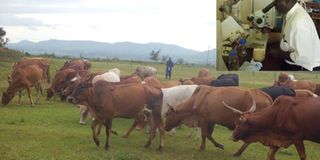Ugandan scientists develop technology for tick borne diseases

Above, a scientist in the laboratory. Below, the animals at the institute on which the research results will be tested before being rolled out to livestock farmers. PHOTO BY LOMINDA AFEDRARU
Outbreaks of animal disease outbreaks are a common occurrence for as long as livestock farmers have domesticated animals categorized as large and small ruminants.
The most common diseases in East Africa are the tick borne diseases but there are a range of others namely East Coast Fever (ECF), trypanosomiasis, helminthiasis, lumpy skin disease, foot and mouth disease (FMD), contagious bovine pleuro pneumonia (CBPP), rinderpest, brucellosis and black water. In Uganda, rinderpest has been eliminated.
Search for fungi
Scientists at the National Livestock Resources Research Institute (NaLRRI) in Tororo are carrying out research for a locally developed solution to treat the ticks.
Dr Halid Kirunda from NaLRRI explains that the most common treatment recommended for farmer use are antibiotics against bacterial pathogens transmitted by ticks such as tetracycline, penicillin, and doxicycline.
NaLRRI is developing fungal acaricides to treat tick borne disease. Dr Richard A. Alingu, an entomologist at the Institute, explains that there are types of fungi in the soil which if developed at the laboratory can kill the ticks. They include metharhizium and Buveria fungi.
They collected soil samples from 10 agro ecological zones in the districts of Oyam, Amuria, Kabarol, Kaberamaido, Kamuli, Agago, Mpigi, Tororo, Kiruhura and Shemma which contain the natural fungi capable of killing ticks and other insects spreading disease to animals.
At the laboratory the fungi will be isolated and put in a media. A single spore will be picked under an isolation done under microscope which is incubated and characterized to see which fungi is capable of killing the ticks.
Previous efforts
The isolate will be mixed with mineral oil out of which a solution will be prepared for spraying the animals.
But before spraying, ticks from different agro ecological zones have been picked for testing exercise to see which fungus solution is capable of killing ticks selected from different locations.
Scientists at NaLRRI had previously developed an acaricide known as Tephrozia volgalli made from plant leaves, which was used to spray animals. The result indicated that about 77 per cent of ticks were killed after applying the spray.
This research started a year ago and it may take them six more months to release the acraicide to farmers.
This is after testing on farm at the institute which is later taken to selected sites in cattle corridors to ascertain its effectiveness before recommending for farmer use.
Countrywide survey
NaLRRI has partnered with Food and Agriculture Organisation (FAO) on a countrywide survey collecting tick species, which resist the existing recommended acaricides. They include the Amidine class, synthetic pyrathodes and organic phosphate.
The survey will also establish whether farmers are using the right method when mixing the acaricide before spraying the animals if not other types will be recommended for use.
Design control measures
Dr Nelson Muhereza a microbiologist is working on a programme where blood samples from farmer kraals are tested against animal anti body resistance for various diseases such as foot and mouth, contagious bovine pleuropneumonia, Peste des petits ruminants, goat plug, Contagious caprine pleuropneumonia, avian influenza and brucellosis among others.
When the team discovers the level of disease in as far as the various diseases are concerned, they will design a control measure and make recommendations to the Ministry of agriculture for possible action.
Usually farmers are advised not to overcrowd the animals in a specific kraal, isolate the sick ones and make structures with good ventilation coupled with occasional vaccination.
The team is also working on a programme to ascertain the level of bacterial in fresh milk which end up causing disease to human beings.
Those dealing in milk value chain are therefore advised to process milk and make it pasteurized and farmers milking cows should ensure they observe maximum hygiene. For those consuming raw milk, they must ensure it is thoroughly boiled.
The situation
The tick-borne diseases of livestock constitute a complex of several diseases whose micro-orgaism agents may be transmitted through sexual intercourse, bacterial or viral infection and their common feature is that they can all be transmitted by ticks.
Impact
Tick borne diseases are present throughout the world, but are most numerous and exert their greatest impact in the tropical regions.
In many countries, they are the major health impediments to efficient livestock production.
On a global basis, the economic toll caused by tick borne diseases is staggering. Better global control of tick-borne diseases of livestock and their vectors would contribute substantially to improved meat and milk production.
Signs
Some of the tick borne diseases include tick fever, which may eventually lead to anaemia caused by protozoan parasites transmitted by a variety of tick species.
Another is bovine anaplasmosis which is an infectious disease of cattle characterised in the acute form of fever, anaemia, weakness, constipation, yellowing of the mucous membranes, lack of appetite, depression, dehydration, and laboured breathing.
Prevalence
There is the East Coast fever caused by the protozoan parasite and recent research carried out by agricultural scientists in East Africa indicates that virulent strains of the viral pathogens may also be involved in the East Coast fever syndrome, which is transmitted by at least nine tick species.
East Coast fever is prevalent in East Africa and has been reported from Tanzania, Kenya, Uganda, Mozambique, South Africa, Rhodesia, DR Congo, Rwanda, Burundi, Malawi and Sudan.
Control
The disease probably exists in Ethiopia, Zambia and southern Somalia. South Africa and Mozambique have reportedly eradicated the disease through tick control.
Others are heart water, infectious disease which infects cattle, sheep, goats and other ruminants and Peste des petis disease among others.




